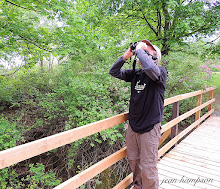November 20
After ticking a Red-throated Loon and a lifer Razorbill (an extremely rare visitor to Niagara) recently, reaching a new personal best for the Ontario year list appeared to be within reach. This late in the year though, the list for possible additions is a short one. Gulls and waterfowl, specifically Black Scoter, Lesser Black-backed Gull and Thayer's Gull are the most likely to be observed before the end of the year (both species of gulls were reported on the 20th). There are other possibilities. California Gull, Cackling Goose, Brant, and even Black Vulture (the species has been observed at the Niagara Gorge over the last two weeks) could be added before the list resets itself on New Year's Day.
Scrutinizing the head, wings and tail of vultures soaring above the lower Niagara River can wait. Hopefully this was the right choice.
It has been almost a year since Jean and I attended our first Peninsula Field Naturalists (PFN) meeting and on Sunday we attended the Niagara Falls Nature Club 'Lake Ontario Ducks' trip with our fellow members of the PFN. There had to be one Black Scoter somewhere along the shoreline of Lake Ontario between Vineland and Hamilton.
At the first stop in Vineland, ducks were sparse, but as we moved west towards Hamilton, the numbers increased greatly. There were hundreds upon hundreds of Common Goldeneye and Long-tailed Ducks and somewhere in these large rafts were scoters.
A few White-winged Scoters were spotted while standing at the end of Fruitland Road. Public access to the Lake Ontario shoreline is in short supply and to view ducks on the lake, dead-ends are a required substitute. Fifty Point Conservation Area in Grimsby is one of the few public spaces for viewing waterfowl and for those lucky enough, our nemesis bird, but for this trip, our stay would be short and would not justify the entrance fee.
From the roadside where we observed our lifer King Eider (female) in December 2008, we spotted the patches of white on the forehead and nape of a male Surf Scoter. Scoping the other dark waterfowl before they disappeared between waves revealed some scoters with a large orange knob at the base of the bill and no white patches in their wings. In total, 2 male Black Scoters were observed. We had some great views of 2 female Black Scoters at Sayer's Park (a tiny patch of green in a residential neighbourhood) before continuing on to spots along Hamilton Harbour.
Due to dredging at the Windermere Basin, the open waters no longer exist. The small channel that remains holds only a small sample of the migrating waterfowl that could be observed in the past.
At the Burlington lift bridge and ship canal, a large number of Long-tailed Ducks were at the east end of the canal.
The resident Peregrine Falcon was spotted when we heard its alarm call and it quickly disappeared from my view after flying through the arch of the skyway. It returned and came to a rest at the top of a hydro tower, south of the lift bridge.
The group's last stop was LaSalle Marina on the north side of the harbour. A great spot for waterfowl, but unfortunately the Ross' Geese observed a week earlier were no longer present and there was nothing new for Jean and I. The highlight for a few of us was spotting a Little Brown Bat as it skimmed the water and then flew above us with the sunlight emphasizing the reddish-brown colour of its fur.
With the trip concluded Jean and I headed back to St. Kitts with one more stop planned. During the week of November 7, a Cackling Goose was observed on the lawn of the Canada Centre for Inland Waters. Though a number of days had past since the sighting, it would be unwise not to stop at the centre. The lawns had a few small flocks of geese, but none contained the much smaller Cackling Goose.
With Black Scoter (#208) safely ticked, my attention can now focus on the Niagara River. A gull or possibly even a vulture may be the next species to appear on the 2011 Ontario list. Which ever one it is, a new bench mark will be set.
Subscribe to:
Post Comments (Atom)












No comments:
Post a Comment